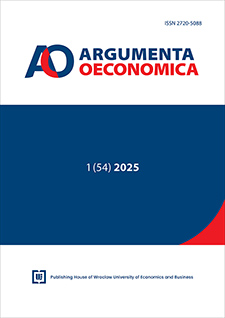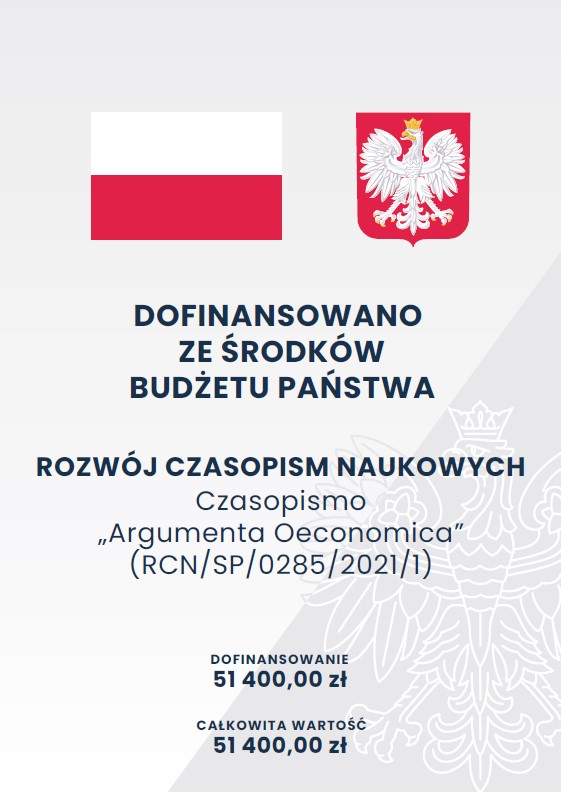Elements of household income and income inequality in selected EU countries
DOI:
https://doi.org/10.15611/aoe.2025.1.01Keywords:
Gini coefficient decomposition, income inequality, Gini coefficient semi-elasticity, pseudo-Gini index, total household gross incomeAbstract
Aim: The aim of this study was to identify the most influential factors impacting the level and dynamics of general income inequalities in Poland, Denmark, Germany, Spain and Romania in the period 2007–2019.
Methodology: The study was based on unpublished individual data from the European Survey of Income and Living Conditions carried out by the European Commission. The research was conducted using the procedure of decomposing the Gini coefficient to the general assessment of inequalities as per income source.
Results: The study enabled the conclusion that the biggest inequalities in household gross income were present in Romania, and the smallest in Denmark. In Romania and Poland income inequalities are slowly but continuously rising, whilst in Denmark, Spain and Germany, they are in decline. The gross income in the analysed EU households was based on three main elements, namely paid employment, self-employment and pensions, which constituted 86-96% of household financial resources. The diversity of inequality was predominantly influenced by the income from paid employment, interests, dividends and profit from capital investments in unincorporated businesses, self-employment as well as old-age benefits; such benefits showed an equalising effect on income inequalities.
Implications and recommendations: Analyses carried out on the basis of microdata can contribute to the formulation of policies, the targeting of interventions, and the monitoring and measurement of the impact of ongoing interventions and policies on the situation of households.
Originality/value: This study contributes to the literature on income inequality by providing a comparative analysis of five European countries, By utilizing unpublished microdata from the European Survey of Income and Living Conditions (EU-SILC), this research offers a novel approach to identifying the distinct contributions of employment income, self-employment, capital income, and pensions to inequality levels. The study's cross-country comparison covering the period 2007-2019 also provides valuable insights into the heterogeneous impacts of socioeconomic policies across both Western and Eastern European countries. This original dataset and analytical approach support the development of more effective, evidence-based public policies aimed at reducing income disparities.
Downloads
References
Alvarez-Garcia, S., Prieto-Rodriguez, J., & Salas, R. (2004). The evolution of income inequality in the European Union during the period 1993-1996. Applied Economics, 36(13), 1399-1408. https://doi.org/10.1080/0003684042000206997
Anghel, B., Basso, H., Bover, O., Casado, J. M., Hospido, L., Izquierdo, M., Kataryniuk, I. A., Lacuesta, A., Montero, J. M., & Vozmediano, E. (2018). Income, consumption and wealth inequality in Spain. Series, 9(4), 351-387. https://doi.org/10.1007/s13209-018-0185-1
Atkinson, A. B. (1970). On the measurement of inequality. Journal of Economic Theory, 2(3), 244-263.
Berisha, E., Meszaros, J., & Olson, E. (2015). Income inequality and household debt: A cointegration test. Applied Economics Letters, 22(18), 1469-1473. https://doi.org/10.1080/13504851.2015.1039698
Berreman, G. D. (2015). Inequality: Comparative Aspects. In W J. D. Wright (Ed.), International Encyclopedia of the Social & Behavioral Sciences (Second Edition) (pp. 894-898). Elsevier. https://doi.org/10.1016/B978-0-08-097086-8.12093-8
Biewen, M., & Juhasz, A. (2012). Understanding rising income inequality in Germany, 1999/2000–2005/2006. Review of Income and Wealth, 58(4), 622-647. https://doi.org/10.1111/j.1475-4991.2012.00514.x
Biewen, M., Ungerer, M., & Löffler, M. (2019). Why did income inequality in Germany not increase further after 2005? German Economic Review, 20(4), 471-504. https://doi.org/10.1111/geer.12153
Bosch, G. (2009). Low-wage work in five European countries and the United States. International Labour Review, 148(4), 337-356. https://doi.org/10.1111/j.1564-913X.2009.00067.x
Breen, R., & Andersen, S. H. (2012). Educational assortative mating and income inequality in Denmark. Demography, 49(3), 867-887. https://doi.org/10.1007/s13524-012-0111-2
Budzyńska, I., & Dobrska, Z. (1990). Rozwarstwienie dochodów a rozwój gospodarczy w krajach Trzeciego Świata. Państwowe Wydawnictwo Naukowe. https://katalog.ue.wroc.pl/161800145074/ksiazka/rozwarstwienie-dochodow-a-rozwojgospodarczy-w-krajach-trzeciego-swiata?bibFilter=16&lokFilter=38
Caminada, K., Goudswaard, K., Wang, C., & Wang, J. (2019). Income inequality and fiscal redistribution in 31 countries after the crisis. Comparative Economic Studies, 61(1), 119-148. https://doi.org/10.1057/s41294-018-0079-z
Cerniauskas, N., & Ciginas, A. (2020). Measurement and decomposition of Lithuania’s income inequality. Baltic Journal of Economics, 20(2), 139-169. https://doi.org/10.1080/1406099X.2020.1780693
Checchi, D., & Garca-Pealosa, C. (2008). Labour market institutions and income inequality. Economic Policy, 23(56), 603-650. https://doi.org/10.1111/j.1468-0327.2008.00209.x
Cowell, F. (2011). Measuring Inequality. Oxford University Press.
Dalton, H. (1920). The measurement of the inequality of incomes. The Economic Journal, 119(30), 348-361.
EUROSTAT. (2020). Methodological guidelines and description of EU-SILC target variables 2019 operation (Version February 2020). European Commission.
Fasianos, A., Raza, H., & Kinsella, S. (2017). Exploring the link between household debt and income inequality: An asymmetric approach. Applied Economics Letters, 24(6), 404–409. https://doi.org/10.1080/13504851.2016.1197360
Gini, C. (1912). Variabilità e mutabilità: Contributo allo studio delle distribuzioni e delle relazioni statistiche. Tipogr. di P. Cuppini.
Głowicka-Wołoszyn, R., & Wołoszyn, A. (2018). Nierówności dochodowe gospodarstw domowych w Polsce w ujęciu regionalnym, 537, 128-137. https://doi.org/10.15611/pn.2018.537.12
Golinowska, S. (2018). Modele polityki społecznej w Polsce i Europie na początku XXI wieku. Fundacja im. Stefana Batorego. https://www.batory.org.pl/publikacja/modele-polityki-spolecznej-w-polsce-i-europie-na-poczatku-xxi-wieku/
Goodman, N. (1988). Wstęp do socjologii. Zysk i S-ka.
Grabka, M., & Kuhn, U. (2012). The evolution of income inequality in Germany and Switzerland since the turn of the Millennium. SSRN Electronic Journal. https://doi.org/10.2139/ssrn.2131220
Gradín, C. (2016). Why is Income Inequality so High in Spain? In Income Inequality Around the World (T. 44, pp. 109-177). Emerald Group Publishing Limited. https://doi.org/10.1108/S0147-912120160000044011
Gustafsson, B., & Shi, L. (2001). The effects of transition on the distribution of income in China – A study decomposing the GINI coefficient for 1988 and 1995. Ecomonics of Transition, 9(3), 593-617. https://doi.org/10.1111/1468-0351.00090
Haussen, T. (2019). Intra-household income inequality and preferences for redistribution. Review of Economics of Economics of the Household, 17(2), 499–530. https://doi.org/10.1007/s11150-018-9410-8
Hayek, F. A. (1960). The Constitution of Liberty. Routledge and Kegan Paul.
Hwang, S., Choe, C., & Choi, K. (2021). Population ageing and income inequality-Web of Science Core Collection. Journal of the Economics of Ageing, 20(100345). https://doi.org/10.1016/j.jeoa.2021.100345
Iacoviello, M. (2008). Household debt and income inequality, 1963-2003. Journal of Money Credit and Banking, 40(5), 929-965. https://doi.org/10.1111/j.1538-4616.2008.00142.x
Ilie, S. (2020). Income inequalities in Romania in the aftermath of the 2008 economic crisis. Journal for Economic Forecasting, 2, 115-130.
Kanbur, R. (2021). Sustainable development goals and the study of economic inequality. The Journal of Economic Inequality, 19(1), 3-11. https://doi.org/10.1007/s10888-020-09452-9
Keynes, J. M. (1936). The General Theory of Employment, Interest and Money (London). Macmillan. https://www.hetwebsite.net/het/texts/keynes/gt/gtcont.htm
Kolm, S. C. (1976). Unequal inequalities I. Journal of Economic Theory, 12, 416-442.
Krajewska, A., & Roszkowska, S. (2016). Płaca minimalna w krajach OECD. Kierunki zmian i wpływ na zatrudnienie i nierówności płacowe. Studia Ekonomiczne / Polska Akademia Nauk. Instytut Nauk Ekonomicznych, 3 (90), 353-395.
Kuznets, S. (1955). Economic growth and income inequality. American Economic Review, 1(45), 1-28. https://doi.org/10.4324/9780429311208-4
Lerman, R. I. (1999). How do Income Sources Affect Income Inequality? In W J. Silber (Ed.), Handbook of Income Inequality Measurement (pp. 341-362). Springer Netherlands. https://doi.org/10.1007/978-94-011-4413-1_13
Leszczyńska, M. (2008). Nierówności dochodów barierą osiągania spójności społeczno-ekonomicznej. Nierówności Społeczne a Wzrost Gospodarczy, 12, 269-279.
Li, Y., Fei, Y., Zhang, X.-B., & Qin, P. (2019). Household appliance ownership and income inequality: Evidence from micro data in China. China Economic Review, 56(101309). https://doi.org/10.1016/j.chieco.2019.101309
Loschiavo, D. (2021). Household debt and income inequality: Evidence from Italian survey data. Review of Income and Wealth, 67(1), 61-103. https://doi.org/10.1111/roiw.12454
Makarenko, E., Nivorozhkina, L., Tregubova, A., Toropova, T., & Nazarova, E. (2022). Risk of increasing income inequality and poverty: Analysis by income source. Sustainability, 14(3), 1610. https://doi.org/10.3390/su14031610
Mazurek-Krasodomska, E. (2017). Dochody gospodarstw domowych i ich determinanty. Zróżnicowanie regionalne w UE. Annales Universitatis Mariae Curie-Skłodowska. Sectio H. Oeconomia, 51 (5), 189-197. https://doi.org/10.17951/h.2017.51.5.189
McLaughlin, C. (2009). The productivity-enhancing impacts of the minimum wage: Lessons from Denmark and New Zealand. British Journal of Industrial Relations, 47(2), 327-348. https://doi.org/10.1111/j.1467-8543.2009.00726.x
Militaru, E., & Stanila, L. (2015). Income variability in Romania: Decomposing income inequality by household characteristics. Procedia Economics and Finance, 26, 227-233. https://doi.org/10.1016/S2212-5671(15)00823-0
Monheit, A. C. (2021). Perspectives article: Income inequality, health, and household welfare. Review of economics of the household, 20(1), 37-55. https://doi.org/10.1007/s11150-021-09589-0
Muszynska, J., Szczepaniak, M., & Wedrowska, E. (2021). Income inequalities in Ireland and Poland: The role of taxes and social Transfers. Economic abd Social Review, 52(4), 375-396.
Nagaj, R. (2013). Rola państwa w niwelowaniu nierówności dochodowych. Studia Ekonomiczne/Uniwersytet Ekonomiczny w Katowicach, nr 139 Współczesne problemy ekonomiczne: polityka państwa a proces globalizacji, 248-259.
Novignon, J. (2017). Household income inequality in Ghana: A decomposition analysis-Web of Science Core Collection. African Journal of Economic and Management Studies, 8(4), 515-526. https://doi.org/10.1108/AJEMS-03-2017-0045
Osberg, L. (2001). Inequality. In P. B. Baltes and N. J. Smelser (Eds.), International Encyclopedia of the Social & Behavioural Sciences, pp. 7371-7377. Pergamon. https://DalSpace.library.dal.ca//handle/10222/72966
Paleologou, S.-M. (2019). In search of thresholds in the household income inequality-growth relationship. Economics of Transition, 27(4), 989–1008. https://doi.org/10.1111/ecot.12228
Pareto, V. (1898). Cours d’Economie Politique. Journal of Political Economy, 6, 549-552.
Pezer, M. (2020). Couples, gender and inequality: The case of Croatia. Web of Science Core Collection. 1237-1245. https://www-1webofscience-1com-1f9f9sszx0222.han.up.poznan.pl/wos/woscc/full-record/WOS:000728402200090
Pigou, A. C. (1912). Wealth and welfare,. Macmillan and Co.
Piketty, T. (2014). Capital in the Twenty-First Century. Harvard University Press. https://www.cambridge.org/core/product/identifier/S0047279415000616/type/journal_article
Piketty, T., & Saez, E. (2003). Income Inequality in the United States, 1913-1998. The Quarterly Journal of Economics, 118(1), 1-41. https://doi.org/10.1162/00335530360535135
Precupețu, I. (2013). Inequality trends in Romania. Calitatea Vieții, 24(3), Article 3.
Przekota, G. (2021). Wybrane koncepcje pomiaru nierówności dochodowych. Nierówności Społeczne a Wzrost Gospodarczy, 66, Article 66. https://doi.org/10.15584/nsawg.2021.2.2
Quintano, C., Castellano, R., & Regoli, A. (2009). Evolution and decomposition of income inequality in Italy, 1991-2004. Statistical Methods and Applications, 18(3), 419-443. https://doi.org/10.1007/s10260-008-0101-0
Raczkowska, M. (2015). Nierówności dochodowe w Polsce w relacji miasto-wieś. Zeszyty Naukowe Szkoły Głównej Gospodarstwa Wiejskiego. Ekonomika i Organizacja Gospodarki Żywnościowej, 112. http://agro.icm.edu.pl/agro/element/bwmeta1.element.agro-e4ec9fc5-595c-46ae-bf19-e57d41e68872
Ridgeway, C. L. (2014). Why status matters for inequality. American Sociological Review, 79(1), 1-16. https://doi.org/10.1177/0003122413515997
Rutkowski, W. (2016). Nierówności ekonomiczne a rozwój gospodarczy i dobrobyt społeczny. Ekonomista, 2, 161-179.
Schmid, K., & Levsen, D. (2013). Explaining Rising Income Inequality in Germany, 1991-2010. https://doi.org/10.2139/ssrn.2339128
Sen, A. (1973). On Economic Inequality. Oxford University Press.
Sen, A. (1991). Welfare, preference and freedom. Journal of Econometrics, 50(1), 15-29. https://doi.org/10.1016/03044076(91)90087-T
Sen, A. (1995). Inequality Reexamined. Harvard University Press.
Sen, A. (1997). From income inequality to economic inequality. Southern Economic Journal, 64(2), 384-401. https://doi.org/10.2307/1060857
Sen, A. (2000). Nierówności. Dalsze Rozważania. Fundacja im. Stefana Batorego.
Sen, A., & Foster, J. E. (1997). On Economic Inequality. Clarendon Press.
Shorrocks, A. F. (1984). Inequality decomposition by population subgroups. Econometrica, 52, 1369-1385.
Skare, M., & Stjepanovic, S. (2014). Income distribution determinants and inequality - International comparison. Web of Science Core Collection. Amfiteatru Economic, 16(37), 980-993.
Solarz, M. (2011). Wykluczenie finansowe jako przejaw nierówności społecznych. Prace Naukowe Uniwersytetu Ekonomicznego we Wrocławiu. Nauki o Finansach, 7(186), 76-89.
Sologon, D. M., Van Kerm, P., Li, J., & O’Donoghue, C. (2021). Accounting for differences in income inequality across countries: Economic Inequality, 19(1), 13-43. https://doi.org/10.1007/s10888-020-09454-7 Tax-benefit policy, labour market structure, returns and demographics. Web of Science Core Collection. Journal of
Stephenson, A. V. (2018). The impact of personal income tax structure on income inequality for Belgium, Bulgaria, Germany, Lithuania, and Poland: A comparison of flat and graduated income tax structures. Atlantic Economic Journal, 46(4), 405-417. https://doi.org/10.1007/s11293-018-9601-y
Szarfenberg, R. (2014). Kontrowersje wokół podniesienia płacy minimalnej. http://rszarf.ips.uw.edu.pl/pdf/placmin.pdf
Sztompka, P. (2002). Socjologia. Analiza społeczeństwa. Znak. http://www.znak.com.pl/ksiazka/socjologia-analizaspoleczenstwa-piotr-sztompka-417
Theil, H. (1967). Economics and Information Theory. North Holland, 488 p.
Tomeczek, M. (2017). Nierówności ekonomiczne jako kategoria opisowa i normatywna. Studia Ekonomiczne, 334, 7-21.
Tusińska, M. (2017). Nierówności dochodowe i ubóstwo w Polsce na tle zmian systemowych. Optimum: studia ekonomiczne, 6(90), 124-133. https://doi.org/10.15290/ose.2017.06.90.10
Wędrowska, E., & Muszyńska, J. (2020). The Role of Social Transfers in Equalizing Income Inequalities in Poland. A Factor Component Decomposition. In S. Soliman Khalid (Ed.) Education excellence and innovation management : a 2025 Vision to sustain economic development during global challenges: proceedings of the 35th International Business Information Management Association Conference (IBIMA), Seville, Spain, 1-2 April 2020, Proceedings of the International Business Information Management Association Conference, 2020, [Norristown, Pa], International Business Information Management Association (IBIMA), pp. 2258-2269.
Wilkinson, R., & Pickett, K. (2011). Duch równości. Tam gdzie panuje równość wszystkim żyje się lepiej. Czarna Owca.
Wołoszyn, A. (2020). Nierówności dochodowe gospodarstw domowcyh w Polsce i ich uwarunkowania społeczno-ekonomiczne. PWN.
Zhou, Y. (2009). The factors that impact income inequality of rural residents in China: Decomposing the Gini coefficient from income components. Frontiers of Economics in China, 4(4), 617-632. https://doi.org/10.1007/s11459-009-0033-0
Zwiech, P. (2013). Nierówności dochodowe w państwach europejskich – Analiza przy wykorzystaniu współczynnika Giniego. Studia Ekonomiczne/Uniwersytet Ekonomiczny w Katowicach, nr 145, Systemy gospodarcze i ich ewolucja: aspekty makro-i mezoekonomiczne, 89-101.
Downloads
Published
License
Copyright (c) 2025 Joanna Maria Kozak, Aldona Mrówczyńska-Kamińska, Andrzej Wołoszyn

This work is licensed under a Creative Commons Attribution-ShareAlike 4.0 International License.








